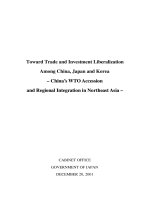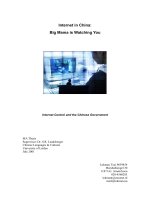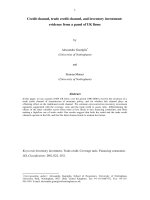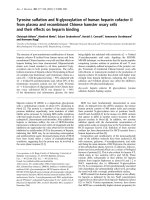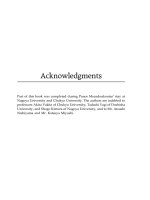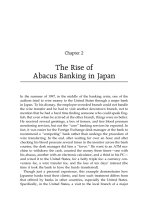Toward Trade and Investment Liberalization Among China, Japan and Korea
Bạn đang xem bản rút gọn của tài liệu. Xem và tải ngay bản đầy đủ của tài liệu tại đây (144.16 KB, 47 trang )
Toward Trade and Investment Liberalization
Among China, Japan and Korea
–
–
C
C
h
h
i
i
n
n
a
a
’
’
s
s
W
W
T
T
O
O
A
A
c
c
c
c
e
e
s
s
s
s
i
i
o
o
n
n
a
a
n
n
d
d
R
R
e
e
g
g
i
i
o
o
n
n
a
a
l
l
I
I
n
n
t
t
e
e
g
g
r
r
a
a
t
t
i
i
o
o
n
n
i
i
n
n
N
N
o
o
r
r
t
t
h
h
e
e
a
a
s
s
t
t
A
A
s
s
i
i
a
a
–
–
CABINET OFFICE
GOVERNMENT OF JAPAN
DECEMBER 20, 2001
Table of Contents
Executive Summary ---------------------------------------------------------------------------------- 1
Introduction -------------------------------------------------------------------------------------------- 4
Chapter 1 China’s WTO Accession: Its Impact on and Implications for
the Chinese, Japanese and Korean Economies -------------------------------- 7
Section 1: Liberalization Measures Accompanying China’s WTO Accession ----------- 7
Section 2: Expectations of Chinese Companies and Foreign Companies in China ------10
Section 3: Model Simulation Results ---------------------------------------------------------- 15
Section 4: Conclusions and Policy Implications ----------------------------------------------20
Chapter 2 Analysis on Free Trade Areas for China, Japan and Korea -------------- 23
Section 1: China, Japan and Korea Facing the Challenge of Worldwide Regionalism ---23
Section 2: Current Status of Intra-Regional Trade --------------------------------------------25
Section 3: Model Simulation Results ---------------------------------------------------------- 28
Section 4: Conclusions and Policy Implications ----------------------------------------------30
Chapter 3 Direct Investment in Northeast Asia – Perspectives and Issues – -----------33
Section 1: Trends in Direct Investment --------------------------------------------------------33
Section 2: Status of Foreign Companies in China --------------------------------------------35
Section 3: Technology Transfer through Foreign Companies in China --------------------38
Section 4: Conclusions and Policy Implications ----------------------------------------------42
Concluding Remarks – Issues for Further Joint-Research -----------------------------------46
Tables and Figures ------------------------------------------------------------------------------------ 47
1
Executive Summary
The three chapters of this report cover an assessment on the impacts of China’s
accession to the WTO (World Trade Organization), an analysis on Free Trade Areas in
China, Japan and Korea, and an analysis on the perspectives and issues of Japanese and
Korean direct investment in China, with a focus on technology transfer. These three
areas represent the major issues related to the trend toward liberalized trade and
investment in Northeast Asia.
(1) China’s WTO Accession: Its Impact on and Implications for the Chinese, Japanese,
and Korean Economies
It is expected that the commitments made by China for accession to the WTO
will generate a wide range of benefits to business both inside and outside China. This
is confirmed by the results of both the GTAP (Global Trade Analysis Project) model
simulation and our questionnaire survey. Our model simulation illustrates that
although the largest proportion of the benefits belong to China herself, Japan and Korea
will also have a greater opportunity to share the benefits provided by China’s WTO
accession. Our survey results show that among foreign companies, Japanese
respondents, as opposed to Korean companies, were more inclined to regard China’s
WTO accession as a major business opportunity.
China’s WTO accession will provide the three countries with opportunities for
further growth. By making structural adjustments in their own economies, Japan and
Korea are going to be able to fully take advantage of liberalized trade and direct
investment relations with China. China needs to bring its WTO commitment to effect.
Among other things, improving business environments is important.
(2) Analysis on Free Trade Areas for China, Japan and Korea
Regionalism, a major world trend for economic integration, has not taken root
in Northeast Asian countries to date, while the degree of trade ties among China, Japan,
and Korea has been strong.
Our simulation using an Applied General Equilibrium Model suggests that the
benefits in terms of GDP (Gross Domestic Product) and economic welfare are larger in
2
cases where three countries join a FTA (Free Trade Agreement) as opposed to when
only two countries do. Furthermore, simulation of a hypothetical FTA between the
three countries plus ASEAN (Association of South-East Asian Nations) indicates that
the benefits are, as expected, the largest.
The simulation result for a Japan-Korea FTA case shows a smaller
macroeconomic benefit than the three-country FTA case, but that might offer a better
chance to lead to a horizontal division of labor, together with firm-level integration.
As this type of integration might involve lesser degrees of a painful adjustment process,
a Japan-Korea FTA might be considered as the first step toward a larger FTA.
(3) Direct Investment in Northeast Asia – Perspectives and Issues
FDI (Foreign Direct investment) in China, Japan and Korea is not necessarily
large. Our gravity model estimate indicates that the FDI flows from Japan to China as
well as to Korea in 2000 were lower than predicted by the regression. This implies
that Japanese FDI to China and Korea has large room for expansion. However,
performance of Japanese and Korean companies in China seems to be not so good
generally.
This situation contrasts with the presence of foreign companies in the Chinese
economy and their rather efficient business performance. In spite of this, the
questionnaire survey result shows that Japanese and Korean companies in China have
expanded their business functions and that they gradually have been entrusting local
staffs with supervisory roles, mainly for expanded functions, which can be regarded as
one type of localization of technology and know-how. Beyond that, they function as a
supply source of experienced staffs for Chinese companies.
As was evidenced by the questionnaire survey result, Japanese and Korean
companies in China desire an improvement in clarification and transparency of rules
and guidelines for business operations. In addition, ensuring quality of managers and
engineers, protection of intellectual property rights and well-prepared infrastructure are
regarded as important issues in technology and know-how transfer by foreign
companies in China.
3
INTRODUCTION
(1) Globalization and Regionalism in Northeast Asia
Globalization has characterized the world economy in the recent years. The
economic integration through freer trade and investment has progressed throughout the
world. The accession of China to the WTO is a symbolic event as the most populous
nation in the world has joined the global institution, with the objective of promoting
trade and investment.
Regionalism is another major trend in economic integration. Most of the
industrial and developing countries in the world have concluded some regional trade
agreements. At present, more than one-third of world trade takes place under such
agreements. In the Asia-Pacific region, regionalism took shape as APEC (Asia-Pacific
Economic Cooperation) at the end of the 1980s. The historic Bogor Declaration in
1994 set a target to achieve free trade and investment in the years 2010/2020. But in
the late 1990s, Asian economies appeared to seek another path for regional integration,
i.e. FTAs in the subset of the Asia-Pacific region. ASEAN has taken action toward
trade liberalization among its members.
Despite the rise of regionalism in Asia, regionalism has not long been familiar
in Northeast Asian countries.
1)
So far, no Northeast Asian country belongs to any trade
blocs. In other words, still ongoing economic integration in Northeast Asia is
exclusively informal, driven by market forces without any institutional support
framework. Notwithstanding, some countries have become interested in bilateral
FTAs, and China, Japan and Korea have been engaged in the ASEAN + 3 process, in
which institutionalization has been proceeding quite rapidly since 1997.
(2) Accelerated Trend Toward Trade and Investment Liberalization
In the context of these three countries in Northeast Asia, a trend of trade and
investment liberalization appears to be accelerated. Trade liberalization measures
committed in the process of China’s WTO accession will undoubtedly stimulate trade
1): This shares a common understanding with Report and Policy Recommendations on
Strengthening Trade Relations between China, Japan and Korea in joint-research by three
research institutions.
4
among the three countries. As a result of WTO related commitments, the Chinese
government will take measures to facilitate inward direct investment.
Partly due to the trend toward trade and investment liberalization in China,
Japan faces a challenge accompanying its massive move of production bases of
Japanese firms to China. Such “industrial hollowing-out” or de-industrialization inside
Japan may be proceeding, and may become a serious issue in terms of assuring
domestic employment. The Japanese economy needs to expedite economic reform in
order to help bring up new industries to absorb the displacement of the labor force.
The governments of Japan and Korea have discussed a FTA. Once an
agreement is made between the two, economic integration of the two countries will
likely change trade and investment structures throughout Asia. In particular,
firm-level integration is expected to take place that will lead to the creation of excellent
companies. Several existing studies have suggested that the most significant feature of
the Japan-Korea FTA would be the promotion of an integration of firms, rather than a
reduction of tariff rates.
(3) How to Utilize the Trend?
It would be mutually beneficial for the three countries to consider a common
perspective to utilize the recent trend of liberalization. Proximity is an asset for the
three countries to strengthen their relations through economic activities. The standard
“gravity model” suggests that countries in near proximity with one another tend to trade
and invest more. As far as trade is concerned, complementarity is high with regard to
bilateral trade between China and Japan, and China and Korea.
Moreover, the geographical location of the three countries may influence an
optimal solution. As indicated above, Northeast Asian countries have not been
involved in any regional trade arrangements, while the two mega-trade blocs, the EU
(European Union) and NAFTA (North American Free Trade Agreement) have
developed. In light of the size of the market, population, technical accumulation, and
many other economic aspects, huge potential would exist in the integration of the three
economies. There can be, however, many other combinations and options.
5
(4) Objectives and Structure of the Report
With an eye towards liberalization, this report will seek common ground and
understanding of the trend in trade and investment between China, Japan and Korea.
An objective analysis will help construct a future foundation to formulate a common
perspective between the three economies.
The report consists of three chapters, each of which touches on current major
hot issues related to trade and investment between China, Japan and Korea.
The first chapter covers an assessment of the impacts of China’s recent WTO
accession. Both an economic model simulation and questionnaire survey analysis will
illustrate industry- and macro-based impacts.
The second chapter assesses the impact of regional integration, assuming
various hypothetical memberships of FTAs. An economic model is utilized to sketch
out the outcomes. An interesting point is who gains the most, and who gains the least
in each of the combinations. Moreover, the analysis may possibly demonstrate what
would be the first and best solution and what would be the second best.
The third chapter is on expanding direct investment. After the boom in the
1980s, direct investment inflow to China from Japan slowed down in the 1990s. It
appears recently, however, that the boom may be reviving. Based on survey data, the
chapter illustrates the behavior of Japanese and Korean companies in China, and the
environments and difficulties they face. The survey data also cover the transfer of
technology and managerial resources from the host economy, which could be the most
desired byproduct of foreign direct investment.
6
Chapter 1 China’s WTO Accession: Its Impact on and Implications
for the Chinese, Japanese, and Korean Economies
Section 1: Liberalization Measures Accompanying China’s WTO Accession
On November 11, 2001, China ratified the text of the agreement for its entry
into the WTO. China’s admission had been approved on the previous day of the WTO
Ministerial Conference held in Doha, Qatar. Now, 15 years after giving notice in 1986
of its desire to resume its status as a contracting party to the GATT (General Agreement
on Tariffs and Trade), China has become the WTO’s 143rd member state.
(1) The Contents of the Liberalization Accompanying WTO Accession
A timetable has been set for opening up China’s market in conjunction with the
country’s entry into the WTO (Table 1-1-1). The following five points describe the
major implications that this market opening will have in terms of economic ties between
China and the rest of the world, including Japan and Korea.
1-1
First, the reduction and elimination of tariffs will prompt a more active
international flow of goods, as well as improve the efficiency of China’s domestic
market. The simple average tariff rate for all goods, which stood at 16.4% as of 2000,
is to be reduced to 10.0% by 2006. Likewise, the tariff rate for industrial goods is to
be brought down to 8.9% by 2010. Additionally, the accession agreement stipulates
such matters as the liberalization of systems in connection with state trading entities and
the elimination or settlement of non-tariff measures that conflict with WTO agreements
by mutually agreed upon terms and timetables.
Second, the liberalization of systems related to services and foreign direct
investment will accelerate the international flow of not only goods but also services and
people. In the accession agreement China pledges to fulfill obligations on the basis of
the GATS (General Agreement on Trade in Services) and to abide by the Schedule of
1-1: The information that follows is not taken directly from the Chinese membership agreement,
which reportedly consists of more than 1,500 pages. It is instead based on newspaper
accounts and such WTO documents as the Draft Report of the Working Party on the
Accession of China (Revision) (WT/ACC/SPEC/CHN/1/Rev. 8 and
WT/ACC/SPEC/CHN/1/Rev.8/Corr.4), which was issued on July 31, 2001.
7
Specific Commitments. Additional promises include raising China’s cap on the ratio
of foreign ownership in telecom businesses – from 25% following accession to 35% one
year later and then 49% after three years – and doing away with regional operating
restrictions in this sector after five years from the accession. Additionally, the
establishment of joint ventures with foreign equity stakes up to 51% is allowed in the
non-life insurance industry as soon as China has become a WTO member, and non-life
insurance businesses that are wholly foreign-owned will be possible after two years.
The agreement also provides for the gradual liberalization of foreign participation in
such sectors as life insurance, insurance for large-scale commercial risks, banking and
distribution.
Third, the application of the principle of non-discriminatory treatment for all
parties, regardless of nationality, will create a level playing field for Chinese and foreign
businesses. A pledge to practice non-discriminatory treatment of all WTO members is
part of the accession agreement. One example is the right to import and export goods.
Now limited to 35,000 Chinese companies, this right will be extended to all companies
through a gradual process of relaxation over a three-year period following China’s WTO
accession. Non-discriminatory treatment is also expected with respect to the
procurement of goods and services necessary for the production of goods as well as to
conditions for the production and sale of goods for China’s domestic market and for
exports. This standard will also apply to public utilities, that is, activity in the areas of
transport, energy and basic telecommunications. Furthermore, exclusive state trading
is to be phased out over a three-year period.
Fourth, the liberalization of systems for doing business in China will heighten
linkage between the country’s business environment and the global arena. Although
China is shifting toward a market economy, its price control system remains in place.
In the case of production inputs, for instance, government regulated prices apply to
9.6% of all products, government guidance prices to 4.4%, and non-regulated prices to
86.0% (Table 1-1-2). Liberalization in this sphere will make the production structure
mirror China’s endowment of resources.
8
Fifth, improvement of the environment for doing business in China will advance
the country’s integration with the rest of the world as both a market and a production
base. The accession document has provisions for various measures in this regard.
One of these is observance of the WTO’s TRIMS (Trade-Related Investment Measures)
agreement through the elimination of local content requirements, export performance
requirements, and foreign-exchange balancing and trade balancing requirements,
including constraints in connection with China’s Industrial Policy for the Automotive
Sector. Also built into the agreement are China’s pledges to fully implement the
TRIPS (Trade-Related Aspects of Intellectual Property Rights) agreement, to implement
the Sanitary and Phytosanitary Measures (SPS) agreement, and to consider participation
in the GPA (Agreement on Government Procurement). Furthermore, along with the
establishment and reinforcement of these individual agreements and systems, the
accession document stipulates that there will be a review of China’s laws for the
purpose of ensuring their consistency with WTO agreements. It also defines a
framework for making and enforcing policies to be carried out by China’s central
government in order to ensure that the country’s local authorities cooperate in the
fulfillment of obligations on the basis of WTO agreements.
(2) The Possibilities Inherent in the Liberalization Accompanying WTO Accession
The kinds of liberalization measures outlined above are to be implemented in
steps. The results of this process will bring about such economic effects as changes of
industrial structure, but this will take a longer time. Plus, there is yet another
remaining problem: ensuring the feasibility of implementation.
In this respect, along with the need to allow time for the anticipated effects of
China’s WTO membership to fully materialize, it is thought that further efforts and
cooperation will be absolutely essential. Additionally, in that process, structural
adjustment of domestic industries will be inevitable. The arrival of newcomers will
lead to keener competition even for foreign companies that are already located in China.
To be sure, China needs to respond to the new environment accompanying
liberalization in a more transparent way. In this regard, the fact that, as described
above, a time frame for changes has been established as an international commitment
and the specifics of liberalization have been spelled out is of great significance.
9
This point is significant because, even though China has achieved rapid
economic growth while reforming its economic institutions, lingering problems have
been mentioned on more than a few occasions. The specific issues that have been
raised are uncertainties and unpredictable change in the business environment in China,
which is still in a reform phase. Actually, some WTO member states even brought up
these concerns during the Working Party consultations for China’s membership. For
that reason, China has promised to introduce international rules in connection with
joining the WTO. The predictability and transparency of the country’s economic
climate and operating environment are thus expected to improve. From the
perspective of Japan and Korea – which are in geographical proximity to China – the
existence of a more open and more transparent China could present a valuable
opportunity.
Japan and Korea, which are at different development stages than China, see a
chance to increase the sophistication of China’s industrial structure while building new
regional complementary ties. Moreover, aside from trade relations, the ties that Japan
and Korea have with China in terms of direct investment in the country have not
necessarily been that extensive up until now. Free trade and investment with China
will also provide Japan and Korea with an opportunity to undertake structural
adjustments and improve efficiency in their own economies.
Accordingly, while there are questions about how to react to the process of
change, China’s entry into the WTO holds the potential to create huge benefits for both
Japan and Korea. These benefits will be discussed later in this report.
Section 2: Expectations of Chinese Companies and Foreign Companies in China
Upon joining the WTO, China will comply with the organization’s rules and
gradually open up and liberalize its own regimes for trade and direct investment.
These moves can be expected not only to accelerate the integration of China’s economy
with that of the world but also to lead to the development of an economic climate
featuring higher predictability.
10
As is evident in the simulation results presented in Section 3, although the
extent of the impact will differ depending on the country, China’s WTO accession is
expected to generate positive macroeconomic effects for China, Japan, and Korea. But
that expectation notwithstanding, there is an undeniable possibility – at least until
adjustment has been accomplished – that some Chinese businesses and industries may
encounter intensified competition because of increased import activity. That will be
generated by the expansion of and changes in the inflow of trade and direct investment
reflecting the new climate in China.
In order to investigate the micro-level effects that were not sufficiently
explained in macroeconomic statistics, we conducted a survey in the form of a
questionnaire. That survey, which targeted Chinese companies and foreign companies
that have set up operations in China, focused on how their business activities will be
affected by China’s WTO entry.
1-2
As for industrial sectors, we focused on mainly the
electronic and electrical equipment sectors that will be affected most by China’s WTO
accession. In this respect, as it was targeted industries that were focused on, the results
of the survey should not be generalized too much.
(1) Assessment of the Present Business Environment in China
First, the survey results indicate that companies currently face rules and
guidelines in multiple areas, with the exception of the realm of hiring and training
(Figure 1-2-1). Second, a number of companies believe that the rules confronting
them do not necessarily exist in any statutory form, with respect to local content
requirements, reinvestment obligations, their selection of partners, and the
establishment of R&D activities. The third point is that, depending on the country of
domicile of a company investing in China, there are differing circumstances in terms of
the rules and guidelines that businesses have faced (Figure 1-2-2).
Of course, the line-up of rules and guidelines being referred to in this case
include items of a purely economic nature as well as policies linked to social objectives.
1-2: The survey targeted 700 Chinese companies and foreign companies with operations in
China. Conducted in the form of visits to companies, the survey took place from late
August to late October of 2001. The total number of firms that responded was 370. Table
1-2-1, which appears later in this report, provides a profile of the respondents.
11
Accordingly, the actual percentage of companies that encounter rules and guidelines is
not necessarily a problem in and of itself. Additionally, we should keep in mind that
the results may include cases in which respondents did not understand the basis of rules
and guidelines. Or the results may, for example, reflect differences related to the
position that laws occupy within the society of the respondent’s own country.
However, if the points that were in dispute during the accession negotiations
and the commitments made by China are taken into consideration, the undeniable
conclusion must be that, at least, there is room for further improvement in terms of the
clarification and transparency of rules and guidelines. In response to such concerns of
WTO member states, China has promised that its central government will make local
governments comply with obligations in connection with the WTO accession agreement
and will also enforce relevant laws in a uniform manner.
Such an analysis may be supported by the difference of circumstances between
Japanese and Korean businesses. Japanese businesses show a pronounced propensity
to move into the area around the delta of the Chang Jiang River, while Korean firms are
strongly inclined to choose such locations as the area along the Bo Hai Gulf and China’s
North Eastern Region (Table 1-2-2). Consequently, it is entirely possible that,
according to how local governments implement rules and guidelines in individual
locations, the nature of the problems faced by businesses will end up displaying
different tendencies between Japanese and Korean companies.
To be sure, the impact of corporate attributes that are also associated with
domicile-specific characteristics can also be considered. For example, the survey
showed relatively few instances of Korean companies facing rules and guidance
pertaining to the selection of partners and foreign equity share. But this outcome is not
unrelated to the fact that many of these Korean businesses are the sole investors in their
operations in China (Figure 1-2-3).
12
(2) Assessment of China’s WTO Accession
The survey results reveal that, in keeping with the above observations – and
perhaps in the context of the circumstances of foreign companies in China – there were
many companies with the view that progress in liberalization in conjunction with
China’s WTO entry will provide benefits for business (Figure 1-2-4).
Asked about the specific effects of WTO accession, many businesses identified
aspects connected to foreign direct investment in China, and following that there was a
relatively large number of companies envisioning an impact on the trade front (Figure
1-2-5). Conversely, the number of companies expecting to see an impact due to the
liberalization of services was low, perhaps because of the survey’s machinery-industry
focus.
However, views on the effects of China’s WTO accession for businesses are
different depending on the country of domicile.
In comparison with the view held by foreign companies, Chinese companies
tend to think less positively about the impact of WTO membership. This probably
reflects the aforementioned sense of crisis on the part of local Chinese companies that
will be exposed to global competition. However, if we look at the specific effects of
WTO accession, it is clear that they are not only wary of negative effects but also find
some business chances. Chinese companies stress the expansion of business through
increased exports as most important aspect. One reason is that China’s WTO
membership gives them easier access to the global market. A second probable reason
is related to the removal of restrictions on imports from China. Even though some
discriminatory measures against Chinese imports will remain in place – such as the
special transitional safeguard mechanism whose continued existence for the first 12
years of China’s WTO membership has been built into the accession agreement – it is
expected that prohibitory and numeral measures that conflict with WTO agreements and
are now applied to goods imported from China will be gradually eliminated.
13
In contrast, foreign companies show a stronger tendency than their Chinese
counterparts to think positively about the impact of WTO membership. They tend to
put greater importance on market revitalization through the expansion of imports and
keener competition due to an increase of foreign direct investment. The former
perception can be seen as stemming from the expectation that not only will Chinese
tariffs be reduced but there will also be an expanded degree of freedom on the import
front in connection with local business activities within China thanks to the
liberalization of trading rights. As for the latter, it is likely that the scenario envisioned
involves brisker competition among foreign businesses as a result of new direct
investment from overseas.
Among foreign companies, Japanese respondents were highly inclined to regard
China’s WTO accession as a major chance. This positive outlook on the part of
Japanese companies is a tendency that can also be seen in other studies.
1-3
On the
other hand, Korean companies tended to have a relatively sober outlook (Figure 1-2-6).
In specific terms, first, the number of Korean companies making the positive
assessment that progress in liberalization will lead to strengthened competitiveness was
relatively small. Second, despite their expectation that stepped-up imports and foreign
direct investment will create a more active market, the number of Korean businesses
that anticipate stiffer competition was relatively large.
Korean companies’ distinctive assessment of the impact of China’s entry into
the WTO can be understood as follows. As mentioned in Chapter 3, the comparatively
short history of Korean direct investment in China means that its accumulated expertise
and track record are relatively limited. In addition, foreign direct investment by
Korean businesses has also been subject to the impact of the 1997 Economic Crisis and
there is reportedly a growing sense of insecurity on the part of their overseas
subsidiaries.
1-4
Consequently, it may be thought that Korean businesses are focusing
their attention on the home front to an increasing extent nowadays, rather than being
oriented toward overseas operations.
1-3: A similar tendency is evident, for example, in the results of The 6th Questionnaire Survey
of Japanese Companies in China, which was conducted by the Japan-China Investment
Promotion Organization in March, 2000.
1-4: Seong-Bong Lee, Korea’s Overseas Direct Investment: Evaluation of Performances and
Future Challenges (Korea Institute for International Economic Policy, December, 2000).
14
Furthermore, for most of the Korean businesses that responded to the survey,
the purpose of their presence in China is to produce goods for export to their own
country (Figure 1-2-7). This could explain why these companies are not all that
inclined to develop a local market for the goods they manufacture in China on the
occasion of the reduction of that country’s tariffs and the improvement of the operating
environment there. Rather, Korean companies tend to be much more concerned about
competition – from other foreign firms with production bases in China and Chinese
firms – in the realm of exports bound for Korea. Conversely, though, it can thus be
assumed that this factor will cease to exist as the structural adjustment of the Korean
economy progresses and the country’s business community acquires a more extensive
track record in foreign direct investment. There is, therefore, ample possibility that
Korean companies will do an about-face and take a more aggressive stance vis-à-vis
moving into China.
Section 3: Model Simulation Results
This section estimates the economic effects of China’s accession to the WTO
from a macroscopic viewpoint using a general equilibrium model. As demonstrated in
Section 2, the questionnaire survey indicates that many businesses expect positive
effects from China’s accession to the WTO. These expectations will be compared with
the estimates derived from the economic model.
(1) Summary of Previous Estimates
Originally developed as a world trade model for static analysis, the GTAP
model has been receiving many modifications in recent years for dynamic analysis.
The latest version 6.1 of this model has formally incorporated variables that reflect the
capital accumulation effect, providing the option for performing dynamic analyses.
On China, a couple of working papers discussed the effect of China’s growth
deceleration on the world and the effect of the tariff reduction by other countries on
Chinese exports, as well as an assessment on the impact of China’s WTO accession.
One of the former studies is “China’s Accession to the WTO: Timing is Everything”
(Hertel. T and T. Warmsley) published in September, 2000.
15
As the contents of commitments have become available due to accession, this
study can make the most updated simulation on the latest information on tariff
reduction.
(2) Estimates Derived from the GTAP Model
i) Simulation Scenario
This simulation is conducted to measure the impact of tariff reduction
committed by the Chinese government. While the approach of general equilibrium
models is inherently limited to static analysis, the model builders have tried to widen the
function of the model to assess some aspects of the dynamic effects of trade
liberalization. As a result, the recent models can incorporate a mechanism of capital
accumulation induced by trade liberalization. The mechanism is as follows:
increased incomes caused by an enhanced efficiency of the economy lead to increased
savings, and the increased savings induce an increase in investment, and such an
increase continues until the increased capital stock requires a larger amount of capital
depreciation to balance the net investment.
As a model option, free capital movement is chosen. This option assumes that
there may be changes of the amount of international capital flows, filling the gaps in the
rates of returns of capitals. This simultaneously means that the current / trade balance
may change.
This study uses the latest version 5.0 of the GTAP database released in the
summer of 2001. The simulations cover eight regions, nineteen industries and four
production factors (land, unskilled labor [as the “sluggish” factor], skilled labor [as the
“mobile” factor], and capital [mobile]) with particular emphasis placed on China, Japan,
Korea and their industries susceptible to China’s accession to the WTO. Tables 1-3-1
and 1-3-2 show the areas and industries covered by the simulation.
16
The shocks implemented to the simulation model are as follows:
1. Tariff rates lowered to the level of 17% for grain, agricultural produce, and
processed foods;
2. Tariff rates lowered by 13.85% points for textiles, chemicals, metals,
general machinery, and other products of the manufacturing industries
excluding transportation equipment and electric machinery;
3. Tariff rates lowered to 0% for electric machinery;
4. Tariff rates lowered by 52% points for transportation equipment.
If the above conditions result in any rises to existing tariff rates, no change is
assumed.
ii) Simulation Results
a) China will enjoy considerable increases in output and economic welfare
The simulation result indicates that China’s lowering of its tariff rates after its
accession to the WTO will increase its real GDP by 3.2% and economic welfare by
$13,301 million dollars (Table 1-3-3). On the other hand, China’s trade surplus will
receive an impact to decrease but only by less than 0.1 %; while both real exports and
imports will increase, the increase in imports will exceed this, reflecting the rise in the
rate of return on capital in China and drawing foreign capital.
b) Impacts on sector base: mixed results.
On sector base impact, the production of labor-intensive industries will expand,
and that of capital- and land-intensive ones will decrease. The latter sectors include
grain, food products and transportation equipments. This is because tariff reduction
will lead to revelation of the comparative advantage reflecting the resource endowment
in China.
While capital-intensive industries, in particular automobile manufacturing, may
have an adverse effect in the simulation, actual production of such industries may not
decline. This is because the direct investment inflow is active in the sectors, and the
technological improvement will more than offset the adverse effects.
